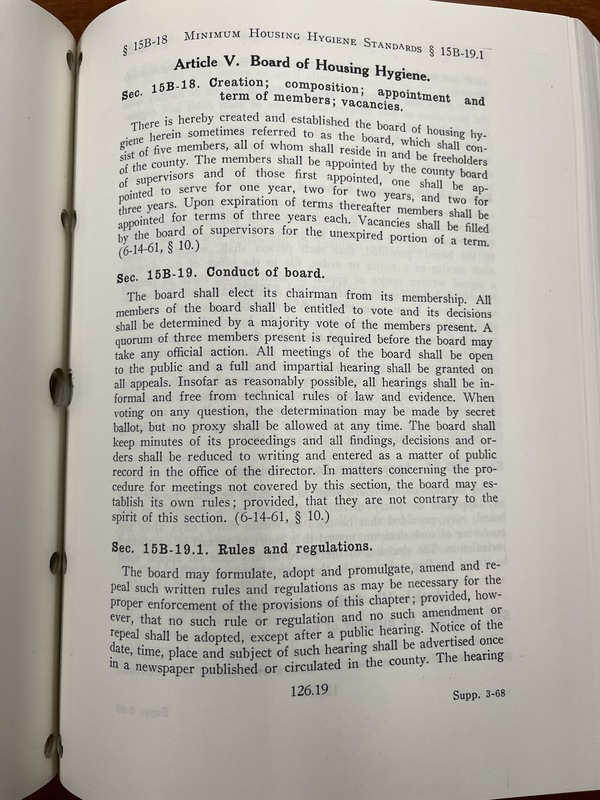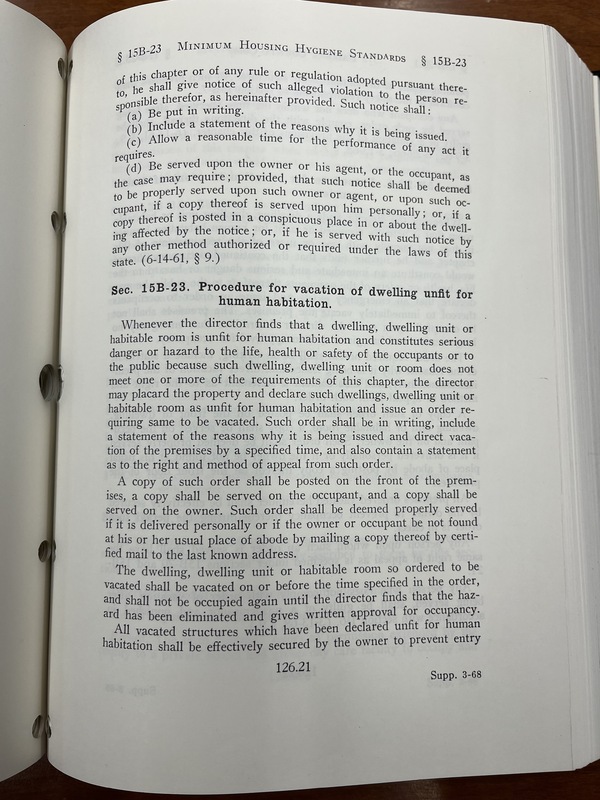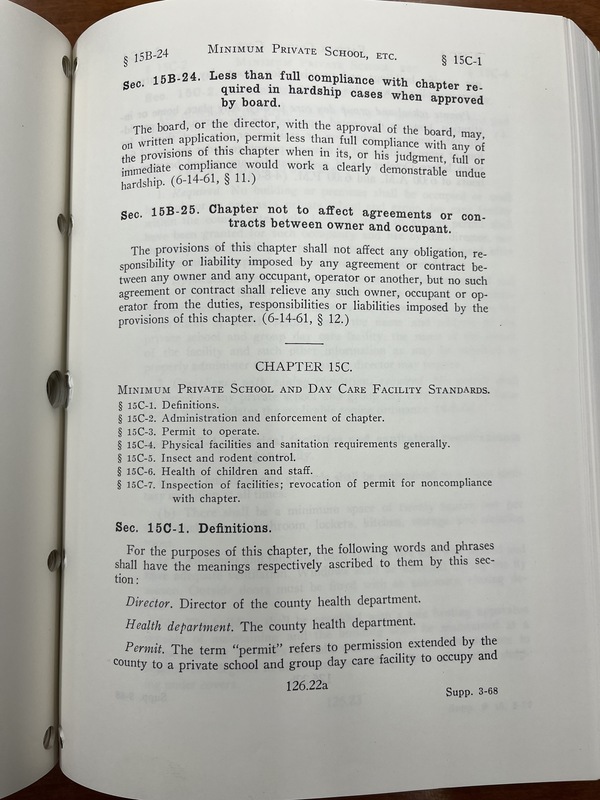Gum Springs: Displaced in Place In Gum Springs
Displacement in place is a violent process. In Gum Springs, that process is demonstrated through layers of uneven development that created structural inequalities. The failure to provide proper funding created countless issues for many in the community as they struggled with constant flooding and housing problems throughout the twentieth-century and problems finding jobs; however, their problems were only bolstered by the passage of the 1961 Minimum Housing Hygiene Standard Code (housing hygiene ordinance). The housing hygiene ordinance significantly impacted the experience of the Gum Springs community throughout the 1960s. The housing hygiene ordinance and the actions by the County represent clear examples of how slow violence through displacement in place created compounding problems in Gum Springs. Displacement in place through unaddressed sewage and drainage infrastructure led to frequent flooding and untenable living conditions for many. Rather than invest in an improved sewage system, Gum Springs residents were subjected to punitive targeted hygiene laws. The laws, in effect, criminalized poverty and activated the physical displacement of Gum Springs residents.
Gum Springs has long dealt with drainage issues. When he owned the region, it was one of George Washington's least favorite regions to travel through, decades before West Ford purchased the land from a later owner.[1] As reports and newspaper articles note, by the 1960s Gum Springs' flooding problem had become serious. The main factor maintaining the poor drainage conditions was that no proper infrastructural systems were implemented to tackle the problem, even though the problem had been known for decades.
As Danielle Purifoy and Louise Seamster posit in “Creative extraction: Black towns in white space”, Black founded towns are less likely to have municipal structures as their development and existence are not tied to or perceived as beneficial to white populations and thus receive a comparative “lack of historic white economic and political investment.”[2] Gum Springs’ continual issues with flooding and drainage demonstrate Purifoy and Seamers’ point, while also affirming Andrea Roberts and Maia Butler’s central theme of displacement in place as a subjugation of Black claims to a sense of place by making Black space illegible through omitting Black spaces from urban planning and preservation.[3] While the community worked tirelessly to maintain their structures and held strong connections with each other, they were nonetheless saddled with countless problems that reflected the hierarchical structures of racial capitalism and the neglect-fueled nature of displacement in place.
Only until the problem became a barrier to the encroaching affluent and white majority did the County begin to address the flooding and drainage problems in Gum Springs and improve its residents' living standards. Funding for drainage ditches and proper sewerage and drainage pipes started in the 1960s; however, these remained too little, too late for many residents, as the damage to their livelihoods was already done.[4] In the case of actual investment, such as in 1961, multiple parties, including the County Engineer, viewed the choice of a drainage ditch as inadequate and underfunded.[5] Decades of compounding problems, reinforced by Jim Crow racism, had bred a multitude of issues for those in Gum Springs. These included a lack of proper housing, unsafe conditions, and a lack of attainable jobs and home opportunities.
For many in Gum Springs, the problem was only exacerbated by the County's movement to pass a minimum housing hygiene standard. While discussions started in 1959 on whether to create a housing hygiene ordinance, beginning in 1960 hearings on the topic by the County Board of Supervisors began. Articles by local newspapers show the fervor surrounding the topic, particularly in the choice of words by the authors, which was also noted in the previous section (Progress in the county is only progress for some).
County reports showed that while the number of homes and areas that accounted for poverty and residential blight in the County were minimal, 8.5 percent of homes in the County, the largest concentration by far was in Gum Springs.[6] The choice of words by authors, and officials in the County triggered a direct attack on a Black geography, and reinforced the existence of slow violence and displacement in place that had produced the conditions. Now Gum Springs faced an even more significant challenge – a looming eviction crisis.
Central to the housing hygiene ordinance was its eviction clause. The clause gave the County Health Supervisor, Harold Kennedy, the ability to placard homes, force compliance, evict residents until improvements were completed, and demolish unrepaired homes. Eviction would require finding other housing in the meantime, which is one of the largest issues in the County. An appeal process to the County Board of Housing Hygiene – created by the ordinance – did exist, and hardship cases could be appealed if “immediate compliance would work a clearly demonstrable hardship.”[7]
In an all-Black location like Gum Springs, where the average income at the time (1960-1961) was much lower than the rest of the County, finding housing within their income range was a challenging task. One article from the Fairfax County Sun Echo stated, “There is almost not adequate housing to be obtained for Negroes in Fairfax County at any price.”[8] According to newspaper reports, though the mood surrounding the passage of the housing hygiene ordinance was positive, many felt the eviction clause was too severe and would place too great a strain on those who would have to move while waiting for improvements or rebuilds.[9] Many Gums Springs residents faced physical displacement, often with nowhere to go but to their family. However, due to the housing hygiene ordinance, only a certain number of individuals could occupy a space per square foot, further limiting options.[10]
Like five decades prior in Tinner Hill and Falls Church, the threat of physical displacement loomed for the Black community, but for many they were able to escape the threat. Over the next five years, 67 housing units were demolished and 14 were updated or rehabilitated to ordinance standards.[11] For many who faced eviction the hardship appeal process was used as the problem of finding any affordable housing was an issue for all, not just Gum Springs residents. Compounding efforts of community organizing throughout the next five years meant that in 1966, the County Board of Supervisors indefinitely suspended evictions and sent all cases directly to the Board of Housing Hygiene – effectively stifling the potential for physical displacement by eviction and circumventing the obstinate Mt. Vernon representative in the County Board of Supervisors.[12] This did not end displacement in place or physical displacement in Gum Springs – the same problems existed for the community. However, it illustrates the power of the community’s efforts to push for change after decades of problems had culminated in a potential eviction crisis. Their push for change would only grow in the coming years.
[1] Judith Saunders Burton, “A History of Gum Springs, Virginia: A Report of a Case of Leadership in a Black Enclave” (Doctoral Dissertation, Nashville, TN, George Peabody College for Teachers of Vanderbilt University, 1986), City of Fairfax Regional Library (Virginia Room), 16.
[2] Danielle M Purifoy and Louise Seamster, “Creative Extraction: Black Towns in White Space,” Environment and Planning D: Society and Space 39, no. 1 (February 1, 2021): 49-50.
[3] Andrea Roberts and Maia Butler, “Contending with the Palimpsest: Reading the Land through Black Women’s Emotional Geographies,” Annals of the American Association of Geographers 112, no. 3 (2022): 829.
[4] John Terry Chase, Gum Springs: The Triumph of a Black Community (Fairfax, Virginia: Heritage Resources Program of the Fairfax County Office of Comprehensive Planning, 1990), 71; John Lawson, “Fairfax Votes $70,000 For Gum Springs Ditch,” The Evening Star, April 13, 1961, 109th Year, No. 103 edition, America’s Historical Newspapers; “Sewer Contract, Trailer Agreement Approved,” Northern Virginia Sun, December 24, 1964, Vol. 28, No. 69 edition, sec. Christmas Present: Housing for Gum Springs Evictees, Library of Virginia.
[5] John Lawson, “Fairfax Votes $70,000 For Gum Springs Ditch,” The Evening Star, April 13, 1961, 109th Year, No. 103 edition, America’s Historical Newspapers.
[6] “A Tool Is Forged Fairfax Attacks Its Slums,” Northern Virginia Sun, June 16, 1961, Vol. 24, No. 218 edition, sec. Editorial, Library of Virginia; Fairfax County Board of Supervisors, Neighborhood Analysis: Gum Springs, Mount Vernon District, Fairfax County, Virginia, Neighborhood Analysis (Fairfax County, Virginia: County of Fairfax, Virginia, 1967), 9-11.
[7] Fairfax County (Va.), “Chapter 15B. Minimum Housing Hygiene Standard Code,” in The Code of the County of Fairfax, Virginia: The General Ordinances of the County. (Fairfax County, Virginia: Michie, 1961), 126.18.
[8] “Commission Asking Law Penalizing Slum Housing,” Fairfax County Sun Echo, November 22, 1960, Vol. 22, No. 8 edition, Library of Virginia.
[9] Ibid.
[10] Fairfax County (Va.), “Chapter 15B. Minimum Housing Hygiene Standard Code,” in The Code of the County of Fairfax, Virginia: The General Ordinances of the County. (Fairfax County, Virginia: Michie, 1961), 126.16 to 126.22a; Julian Morrison, “Case for ‘Minimum Standard?’ 26 Live in Single House in Fairfax,” Northern Virginia Sun, February 25, 1961, Vol. 24, No. 123 edition, Library of Virginia.
[11] “LWV Tour Shows Need Of Housing,” Northern Virginia Sun, October 24, 1964, Vol. 28, No. 17 edition, Library of Virginia; Fairfax County Board of Supervisors, Neighborhood Analysis: Gum Springs, Mount Vernon District, Fairfax County, Virginia, Neighborhood Analysis (Fairfax County, Virginia: County of Fairfax, Virginia, 1967).
[12] William Reddig, “Board Acts to Relieve Gum Springs Residents,” The Evening Star, May 19, 1966, 114th Year, No. 133 edition, America’s Historical Newspapers.




